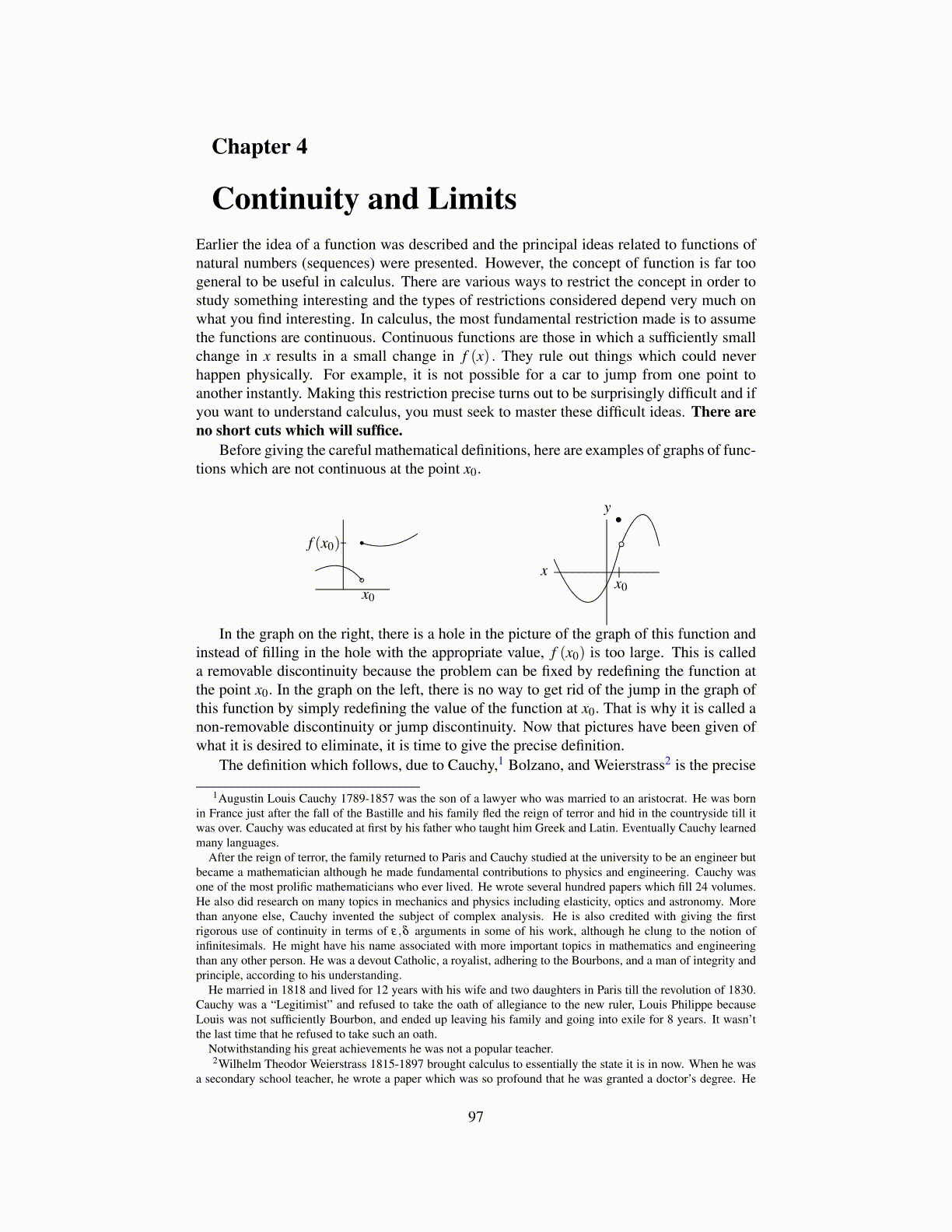
Chapter 4
Continuity and LimitsEarlier the idea of a function was described and the principal ideas related to functions ofnatural numbers (sequences) were presented. However, the concept of function is far toogeneral to be useful in calculus. There are various ways to restrict the concept in order tostudy something interesting and the types of restrictions considered depend very much onwhat you find interesting. In calculus, the most fundamental restriction made is to assumethe functions are continuous. Continuous functions are those in which a sufficiently smallchange in x results in a small change in f (x) . They rule out things which could neverhappen physically. For example, it is not possible for a car to jump from one point toanother instantly. Making this restriction precise turns out to be surprisingly difficult and ifyou want to understand calculus, you must seek to master these difficult ideas. There areno short cuts which will suffice.
Before giving the careful mathematical definitions, here are examples of graphs of func-tions which are not continuous at the point x0.
f (x0)
x0
x
y
x0
In the graph on the right, there is a hole in the picture of the graph of this function andinstead of filling in the hole with the appropriate value, f (x0) is too large. This is calleda removable discontinuity because the problem can be fixed by redefining the function atthe point x0. In the graph on the left, there is no way to get rid of the jump in the graph ofthis function by simply redefining the value of the function at x0. That is why it is called anon-removable discontinuity or jump discontinuity. Now that pictures have been given ofwhat it is desired to eliminate, it is time to give the precise definition.
The definition which follows, due to Cauchy,1 Bolzano, and Weierstrass2 is the precise
1Augustin Louis Cauchy 1789-1857 was the son of a lawyer who was married to an aristocrat. He was bornin France just after the fall of the Bastille and his family fled the reign of terror and hid in the countryside till itwas over. Cauchy was educated at first by his father who taught him Greek and Latin. Eventually Cauchy learnedmany languages.
After the reign of terror, the family returned to Paris and Cauchy studied at the university to be an engineer butbecame a mathematician although he made fundamental contributions to physics and engineering. Cauchy wasone of the most prolific mathematicians who ever lived. He wrote several hundred papers which fill 24 volumes.He also did research on many topics in mechanics and physics including elasticity, optics and astronomy. Morethan anyone else, Cauchy invented the subject of complex analysis. He is also credited with giving the firstrigorous use of continuity in terms of ε,δ arguments in some of his work, although he clung to the notion ofinfinitesimals. He might have his name associated with more important topics in mathematics and engineeringthan any other person. He was a devout Catholic, a royalist, adhering to the Bourbons, and a man of integrity andprinciple, according to his understanding.
He married in 1818 and lived for 12 years with his wife and two daughters in Paris till the revolution of 1830.Cauchy was a “Legitimist” and refused to take the oath of allegiance to the new ruler, Louis Philippe becauseLouis was not sufficiently Bourbon, and ended up leaving his family and going into exile for 8 years. It wasn’tthe last time that he refused to take such an oath.
Notwithstanding his great achievements he was not a popular teacher.2Wilhelm Theodor Weierstrass 1815-1897 brought calculus to essentially the state it is in now. When he was
a secondary school teacher, he wrote a paper which was so profound that he was granted a doctor’s degree. He
97